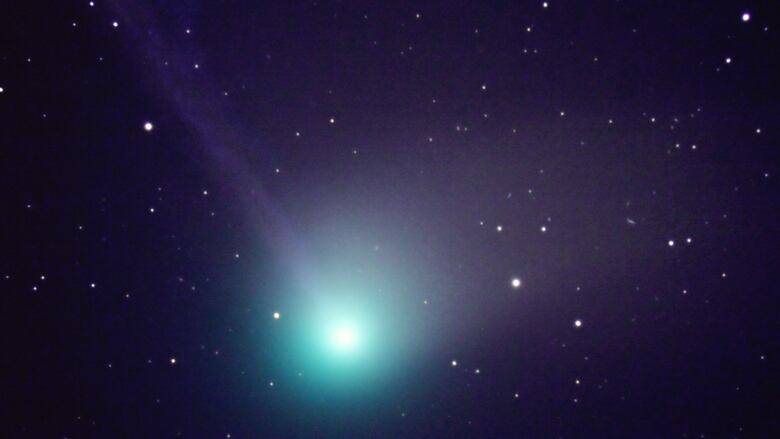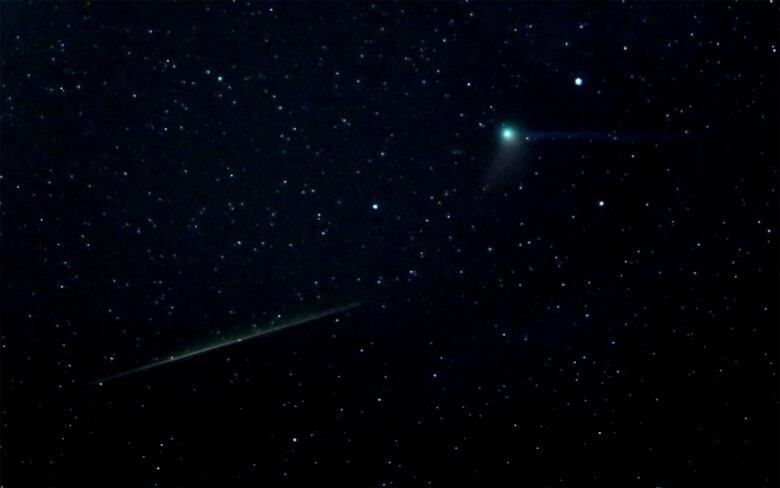Comet Catalina makes closest approach this weekend
After Jan. 17, you have a very limited time before comet disappears forever

Your only chance to see a green, two-tailed comet named Catalina is almost over, as the comet makes its closest approach to Earth this weekend.
On Sunday, the comet, officially named C/2013 US10 will pass within 110 million kilometres of Earth (not very close about 72 per cent of the distance between the Earth and the Sun) on its way to leave our solar system forever after a one-time visit.
For the next few days,it should be visible with binoculars near a very well-known constellation.
"It's fairly easy to spot right now.It's very close to the end star in the handle of the Big Dipper," saysPaul Klauninger, an astronomy lecturer and astrophotographerbased in Lanark Highlands, about 50 kilometres west of Ottawa. Hehas been observing and photographing the comet for weeks from his backyard observatory.
It should appear as a "fuzzy, perhaps slightly greenish coloured star," he told CBCNews.ca in a phone interview.

"Try looking in the wee hours after midnight, or before sunrise," recommends the astronomy news website EarthSky.
Following the comet'sclosest approach, "its best days are then behind it. Catch it soon before it disappears forever!" suggests the astronomy website freestarcharts.com.
Dimmer each day
The comet has been visible in the northern hemisphere since late November,andKlauningersays itis already much dimmer than it was in late December and early January.
At that point, hecould see the coma,the gas cloud surrounding the head of the comet, with the naked eye in the very dark skies of rural eastern Ontario.
"And the tail was easily visible with binoculars," he says.
He managed to take several photos using an ordinary DSLR camera and a technique called "image stacking" to combine multiple images and bring out the details. One even captured a meteor in the same shot.
On Jan. 8, anothereastern Ontario resident, Malcolm Park, one of the organizers of the star-partyStarfest, captured a beautiful image of the comet from his backyard in Bloomfield, Ont.,using a DSLR camera and a420 millimetrefocal length telescope.
here's #comet C/2013 US10 (Catalina) in hazy skies this morning from my backyard @EpicCosmos @AstronomyMag pic.twitter.com/PqVRaupwku
—@Starfest2016Now, Klauningersays, you can't see the comet at all with the naked eyeand the tail is only visible when the sky is very clear.
"It's getting dimmer as each day goes by," he says. That's because it's moving farther and farther from the sun."It's starting to cool down and produce less gas."
It's that vapour, produced as the sun heats up theicy surface, that produces the comamakes the comet bright.
To make matters worse, a full moon is coming up on Jan. 24, and within three or four days, the moon'sbrightness will start to wash out the comet and make it hard to see, Klauninger says.
That means this weekend is "pretty much" your last chance to see the comet.

Comet Catalina, which is less than 20 kilometres across, was discovered in 2013 by the Tucson, Ariz.-based Catalina Sky Survey, which looks for potentially hazardous near-Earth objects. At first, it was thought to be a very large near-Earth asteroid. But astronomers soon realized it was actually a very long, near-parabolic orbit and observations with the Canada-France-Hawaii telescope showed "modest cometary activity" that is, dust and gas spewing from its surface.
Astronomers think the comet originally came in from the Oort cloud, a region full of icy objects such as comets in the distant reaches of the solar system, after its orbit was perturbed by other objects. Now that it has swung past the sun, its current path is expected to permanently eject it from the solar system.












_(720p).jpg)


 OFFICIAL HD MUSIC VIDEO.jpg)
.jpg)



























































































